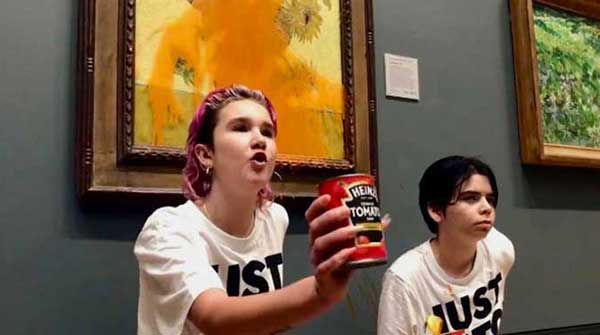 Visiting museums and galleries is an enjoyable pastime in our society. Most people are respectful when walking through rooms and halls containing great works of art. Unfortunately, this isn’t always the case – and it’s led to numerous episodes of vandalism against art exhibits.
Visiting museums and galleries is an enjoyable pastime in our society. Most people are respectful when walking through rooms and halls containing great works of art. Unfortunately, this isn’t always the case – and it’s led to numerous episodes of vandalism against art exhibits.
Leonardo da Vinci’s Mona Lisa (1503) has been attacked on several occasions, including this past May. Rembrandt’s Night Watch (1642) and Edvard Eriksen’s The Little Mermaid (1913) have also been victims of multiple attacks. Lorenzo Costa’s The Holy Family (1490-1510), Diego Velázquez’s Rokeby Venus (1647-51), Michelangelo’s David (1501-04), Pablo Picasso’s Guernica (1937) – and the list goes on.
This month, in particular, has seen a rash of art vandalism caused by far-left extremists.
Two members of Just Stop Oil threw tin cans of tomato soup at Vincent Van Gogh’s Sunflowers (1888) at the National Gallery in London, England, on Oct. 14. They glued their hands on the wall next to the painting in front of several shocked bystanders.
 |
| Related Stories |
| Vandalizing Emily Murphy for no good reason
|
| Destruction, eco-terrorism won’t deliver an energy revolution
|
| Burning churches, toppling statues won’t ease the pain |
“What is worth more – art or life?” one of the left-wing protesters said. “Is it worth more than food? Worth more than justice? Are you more concerned about the protection of a painting, or the protection of our planet and people? The cost of living crisis is part of the cost of oil crisis. Fuel is unaffordable to millions of cold, hungry families. They can’t even afford to heat a tin of soup.”
Two members of Last Generation then threw mashed potatoes at Claude Monet’s Grainstacks (1890-91) at the Barberini Museum in Potsdam, Germany, on Oct. 23. It’s one of the French impressionist artist’s series of 25 paintings originally titled Les Meules à Giverny (The Stacks at Giverny), or more simply known today as Haystacks. Like their British counterparts, the German protesters glued their hands to the wall next to the painting.
“We are in a climate catastrophe. And all you are afraid of is tomato soup or mashed potatoes on a painting,” one left-wing protester said. “This painting is not going to be worth anything if we have to fight over food.”
Fortunately, Sunflowers and Grainstacks have been under protective glass for years. The two paintings were left unscathed, but both frames received minor damage. The former was back on display that same day, and the latter will return on Wednesday.
The protestors were arrested at the scene of both crimes. They will face separate trials and, one can only hope, fines and jail sentences. Anything less than this could lead to a public outcry and more copycats.
When I wrote about the Sunflowers attack in a recent Loonie Politics column, my first thought was simple: how on earth could this have happened?
I went to the National Gallery multiple times when I studied at the London School of Economics between 1994-95 and earned a Master’s degree in comparative politics. I was also there a few years ago on vacation. There was always security present to check coats, bags and other belongings. You couldn’t take most items into a room or hall at the main gallery, other than handheld devices, cameras and so on. The purchase and consumption of food were only permitted in restaurants, cafeterias and other designated eating areas.
I’ve never visited the Barberini Museum. According to its website, the “Hasso Plattner Collection includes more than 100 works. With 38 paintings by Claude Monet, its focus is on French Impressionism.” Two of the 25 Haystacks paintings are housed in Potsdam – and Grainstacks is on permanent loan, having sold for US$110.7 million at auction in 2019. The museum appears to have security guards, and I’d imagine a few of them do their due diligence when individuals and groups of visitors arrive each day. Similar rules to restaurants, cafeterias, and the like must surely apply, too.
Let’s accept this to be the case at both locations. How could these four protesters wearing orange vests have carried tomato soup cans and plates of mashed potatoes to the vicinity of two French Impressionist masterpieces in two different countries – and no one raised an eyebrow or red flag? That’s a huge failure.
It’s not a big secret that the total number of security guards at museums and galleries has long been on the low side. This means sections and rooms dedicated to priceless Baroque and Renaissance art, which aren’t as widely viewed, are often left unattended (other than cameras). Conversely, the more popular works of Impressionism, modern art and special exhibits have higher amounts of security.
That being said, both incidents occurred in rooms where there would have been a higher number of security guards. This is a huge failure, too.
Museums and galleries will have to work hand-in-hand with governments and the private sector to improve these obvious deficiencies in security measures. Far-left extremists will keep finding ways to attack valuable works of art because it gets the eyeballs they desire and media attention they crave. If we don’t nip it in the bud now, it will only get worse later.
Michael Taube, a Troy Media syndicated columnist and Washington Times contributor, was a speechwriter for former prime minister Stephen Harper. He holds a master’s degree in comparative politics from the London School of Economics.
For interview requests, click here.
The opinions expressed by our columnists and contributors are theirs alone and do not inherently or expressly reflect the views of our publication.
© Troy Media
Troy Media is an editorial content provider to media outlets and its own hosted community news outlets across Canada.

